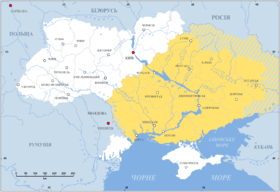Wild Fields
The Wild Fields (Russian: Дикое Поле, romanized: Dikoye Polye, Ukrainian: Дике Поле, romanized: Dyke Pole, Polish: Dzikie pola, Lithuanian: Dykra, Latin: Loca deserta or Latin: campi deserti inhabitati, also translated as "the Wilderness") is a historical term used in the Polish–Lithuanian documents of the 16th to 18th centuries[1] to refer to the Pontic steppe of Ukraine, north of the Black Sea and Azov Sea, the South and the East Ukraine. According to some historians the term appeared sometime in the 15th century when a colonization of the region by Cossacks started.[2]

The somewhat ambiguous location has been usually defined as lying between the midstream of Volga River on the east, Kiev on the north, and the Dniester on the west.[2] The term's contemporaries, such as Michalo Lituanus,[3][4] Blaise de Vigenère, and Józef Wereszczyński,[5] wrote about the unseen natural riches of the steppes and the Dnieper basin.[2]
The territory was ruled by the Golden Horde until the Battle of Blue Waters (1362), which allowed Algirdas to claim it for the Grand Duchy of Lithuania. As a result of the Battle of the Vorskla River in 1399, his successor Vytautas lost the territory to Temur Qutlugh, the khan of the Golden Horde. In 1441 the western section of the Wild Fields, Yedisan, came to be dominated by the Crimean Khanate, a political entity controlled by the expanding Ottoman Empire from the 16th century onward. The Wild Fields were also dominated by the Zaporizhian Cossacks, as reflected in works of the Polish theologian and Catholic bishop of Kiev Józef Wereszczyński.[5] Cossacks explored the fields under condition of permanent fight against population of the Tatar's uluses, Nogai Horde, Crimean Khanate.[2]

The Wild Fields were traversed by the Muravsky Trail and Izyumsky Trail, important warpaths used by the Crimean Tatars to invade and pillage the Grand Duchy of Moscow. The Crimean-Nogai Raids, a long period of raids and fighting between Crimean Tatars, Nogai Horde, Grand Duchy of Lithuania, and the Grand Duchy of Moscow, brought considerable devastation and depopulation to this area before the rise of the Zaporozhian Cossacks, who periodically sailed down the Dnieper in dugouts from their base at Khortytsia and raided the coast of the Black Sea. The Turks built several fortress towns to defend the littoral, including Kara Kerman (Ochakiv) and Khadjibey (Odessa).
By the 17th century, the east part of the Wild Fields had been settled by runaway peasants and serfs who made up the core of the Cossackdom.[6] During the Khmelnytsky Uprising the north part of this area was settled by the Cossacks from the Dnieper basin and came to be known as Sloboda Ukraine. After a series of Russo-Turkish wars waged by Catherine the Great, the area formerly controlled by the Ottomans and the Crimeans was incorporated into the Russian Empire. In the 20th century, the region was divided among Ukraine, Moldova, and Russia.
References
- Camporum Desertorum vulgo Ukraina by Guillaume Le Vasseur de Beauplan, Cum Privilegio S.R.M. Poloniae. Gedani 1648; Campi Deserti citra Boristhenem, abo Dzike Polie Polish–Lithuanian, by Ian Jansson, c. 1663, Amsterdam
- Shcherbak, V. Wild Field (ДИКЕ ПОЛЕ). Encyclopedia of History of Ukraine.
- http://resource.history.org.ua/cgi-bin/eiu/history.exe?C21COM=2&I21DBN=EIU&P21DBN=EIU&Image_file_name=IMG/Mykhalon_Lytvyn.jpg
- Michalo Lituanus, De moribus Tartarorum, Lituanorum et Moscorum fragmina X, multiplici historia referta, 1550.
- Sas, P. Duchy of the Zaporizhian Host, the project of Józef Wereszczyński (КНЯЗІВСТВО ВІЙСЬКО ЗАПОРОЗЬКЕ, ПРОЕКТ ЙОСИПА ВЕРЕЩИНСЬКОГО). Encyclopedia of History of Ukraine
- Kármán, Gábor; Kunčević, Lovro (20 June 2013). "The European Tributary States of the Ottoman Empire in the Sixteenth and Seventeenth Centuries". BRILL. Retrieved 18 April 2018 – via Google Books.